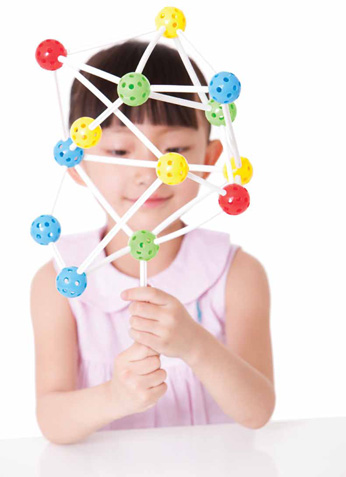
Our 21st century is flooded with advanced knowledge and concepts, and no longer will model answers be accepted. To succeed, it is crucial to develop strong critical thinking and reasoning powers to face the daily challenges and learn how to complete tasks productively. People who can think out of the box with multiple solutions will be a strong asset in future. Think Impact assists students in their learning ‘how’ to think more effectively and productively, aiming for higher grades and fun learning.
To enhance general studies and increase abilities of numerical and linguistic reasoning to achieve higher grades.
Think Impact® curriculum is led and designed by our management and research & development team. For details, please refer to our program modules.
Suitable for 6-16 years old


The main objective of the Think Impact Program is to assist students in their learning ‘how’ to think more effectively and productively. Thinking that is productive will also combine and exercise the abilities of thinking both appropriately and creatively, and to do so in the face of novel challenges of increasing levels of difficulty as the course progresses. Both these faculties are essential for the well-rounded productive thinker.
THINK IMPACT is made up of 5 major experiential learning modules and they are
1. Critical Thinking
2. Critical Reasoning
3. Problem Seeking/Solving
4. Numerical and Spatial Reasoning
5. Linguistic Reasoning

The aims of this module are threefold: Firstly, to enhance each student’s ability and willingness to read a variety of texts, and to pro-actively seek opportunities to do so. Secondly, to develop the ability to discriminate between pieces of information in order to extract significant data features for future memory and action. Thirdly, students will increase their sensitivity to both the formal structural rules of grammar, and to use such linguistic knowledge to construct coherent accounts of their ideas, thinking strategies and conclusions, for others to share.

The aims of this module are threefold: Firstly, to enhance each student’s ability to determine, identify, gather and filter the most appropriate body of information (from amongst distractors) which may be relevant to the problem of interest. Secondly, to learn to recognise, find and select the most appropriate methods or procedures for implementation in solving different types of problem. Thirdly, students will increase their ability (and form the habit) to actively ‘stop and think’, and to choose from amongst multiple alternative solutions, and to identify similarities and differences between the immediate problem situation and those previously encountered.

The aims of this module are sixfold: Firstly, to enhance each student’s understanding of their concepts of number and numerical value(s). Secondly, to develop the ability to perform numerical operations. Thirdly, students will more easily increase their respective understandings of quantification, and of their generalisation of numerical operations to new contexts. Fourthly, students will consolidate their ability to identify different shapes, layouts and spatial contiguities, and to form significant mental maps, navigation plans and perspective models of reality in their ‘mind’s eye’. Fifthly, to significantly improve and continually practice the re-representation of geometric spaces and their contents, spatial relationships and spatial reasoning. Lastly, students will develop a keen ability to design and generate a variety of ways to represent (and re-represent) any given data in graphical forms, and an advanced understanding of how to read tables and graphs as may be produced in support of particular arguments and conclusions.

The learning objectives for this module are to enhance students’ critical and creative reasoning abilities, enabling each thinker to develop the most efficient identification and use of argument in order to determine the truth or validity of any given conclusions. Together with their repeated exposure to novel premise/conclusion sets, multiple representations and reasoned exploration of alternative interpretations of stimulus data (rather than mere descriptions of them), students will come to develop efficient, consistent use of their reasoning skills appropriate to the avoidance of their more natural tendency to draw conclusions based upon unnecessary (and often unwarranted) assumptions. Instead, students will become better able to recognise, categorise, and hierarchically organise, the most critical components of situations, events and relevant data derived from any number of social or academic sources, in order to better process all of the information available to them (to ‘reason through’) for the drawing of excellent conclusions via smart critical reasoning.

The aims of this module are threefold: Firstly, to enhance each student’s ability to detect, identify, evaluate and question the validity of any given facts and supposedly relevant information. Secondly, students will learn to recognise the most appropriate use of factual information for the purposes of argument construction for coherent, critical reasoning. Learning such a skill will in turn facilitate appropriate transfer of newly derived knowledge as may pertain to novel, yet related, challenges of increasing levels of difficulty. Thirdly, students will increase their ability (and desire) to pro-actively engage in creative explanatory thinking, and dynamic interactions with the world of objects and events, in such a way as to ‘automatically’ generate alternative explanations and answers to both solved and unsolved problems.

Think Impact® workbooks are separated to 3 different age groups.
Think Impact® workbooks, which consists of modules of the entire academic year, includes ‘Critical Thinking’, ‘Problem Solving’, ‘Numerical Reasoning’ and more. Through these workbooks, parents can thoroughly understand the progress and performance of their child. Above are sample workbooks for viewing